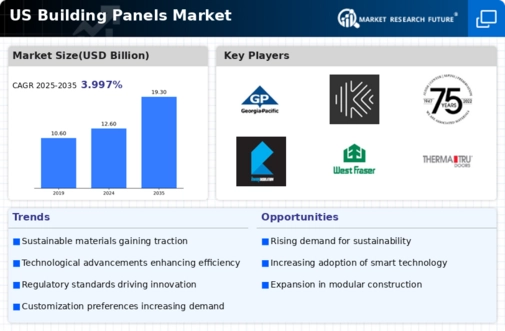Increased Infrastructure Investment
The building panels market is benefiting from a surge in infrastructure investment across the United States. Government initiatives aimed at improving public infrastructure, such as roads, bridges, and schools, are creating a higher demand for building materials, including panels. In 2025, federal and state governments are projected to allocate over $100 billion towards infrastructure projects, which is likely to stimulate growth in the building panels market. This influx of funding not only supports new construction but also encourages renovations and upgrades of existing structures, further driving the demand for innovative building panel solutions.
Rising Demand for Energy Efficiency
The building panels market is experiencing a notable increase in demand for energy-efficient solutions. As energy costs continue to rise, consumers and builders are seeking materials that enhance thermal performance and reduce energy consumption. This trend is particularly evident in residential construction, where energy-efficient panels can lead to significant savings on heating and cooling costs. According to recent data, energy-efficient building materials can reduce energy usage by up to 30%. Consequently, manufacturers in the building panels market are focusing on developing products that meet these energy efficiency standards, thereby driving growth in the industry.
Environmental Regulations and Standards
The building panels market is being shaped by stringent environmental regulations and standards aimed at promoting sustainable construction practices. As states implement more rigorous building codes that require the use of eco-friendly materials, manufacturers are compelled to adapt their product offerings. Compliance with these regulations often necessitates the development of panels that utilize recycled materials or have lower carbon footprints. In 2025, it is anticipated that nearly 50% of new construction projects will be subject to these enhanced environmental standards, thereby driving innovation and growth within the building panels market as companies strive to meet these evolving requirements.
Advancements in Manufacturing Techniques
Innovations in manufacturing processes are playing a crucial role in shaping the building panels market. Techniques such as automated production and advanced material science are enabling manufacturers to produce panels that are not only lighter and stronger but also more cost-effective. For instance, the introduction of modular construction methods has streamlined the building process, allowing for quicker assembly and reduced labor costs. This shift towards more efficient manufacturing is expected to enhance the competitive landscape of the building panels market, as companies that adopt these technologies can offer superior products at lower prices, potentially increasing their market share.
Growing Preference for Prefabricated Solutions
The trend towards prefabrication is significantly influencing the building panels market. Builders and developers are increasingly opting for prefabricated panels due to their ability to reduce construction time and labor costs. Prefabricated panels can be manufactured off-site and then transported to the construction site, allowing for faster project completion. This method also minimizes waste and enhances quality control, as panels are produced in a controlled environment. As the construction industry continues to embrace this approach, the building panels market is likely to see a substantial increase in demand for prefabricated solutions, which could reshape traditional building practices.


















Leave a Comment